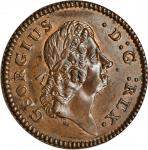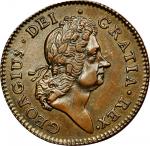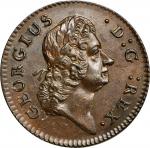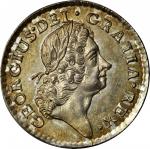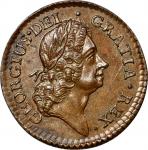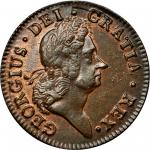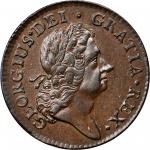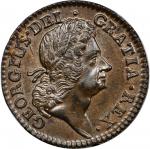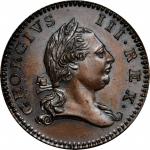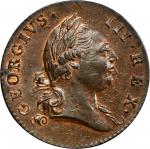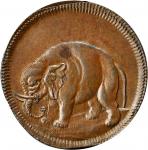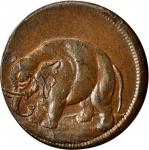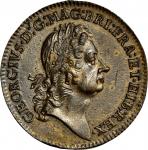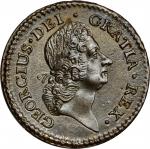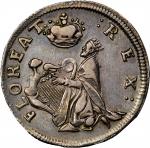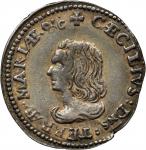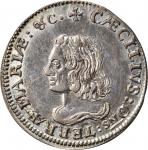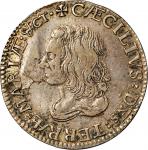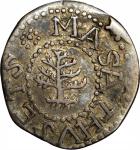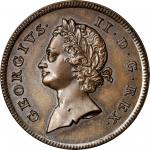1733 Rosa Americana pattern twopence. Martin 1-A, W-1370. Rarity-7. Proof-64 BN (PCGS).265.6 grains. Coin turn. A beautiful example of the single greatest rarity in the Rosa Americana series, coined after the death of William Wood as a final exclamation point before his coining patent was allowed to expire. The surfaces resemble those of the Proof halfpence struck with the young head of George II, beautifully smooth, deeply toned to chocolate brown with some subtle reflectivity and iridescence in shades of navy blue and more. Multiple strikes brought the distinctive bust of George II into extraordinary relief, coined atop a specially prepared planchet that shows finishing marks around its edge. The surfaces are natural, original, and nearly flawless, with just a few minor scattered depressions and lintmarks from the moment of coining. A comma-shaped lintmark on the lowest part of the bust, below the neck but above the truncation, is the most notable of these. The eye appeal, like the detail, is magnificent.<p><p>This issue has been a classic early American rarity since the earliest days of American numismatics. The first auction appearance of a 1733 Rosa Americana twopence can be traced back to the May 1817 sale of the Thomas Brand Hollis Collection. Lot 515 was described as "George II. his Head and Titles, reverse, a Leafed Rose, crowned, inscribed, Rosa Americana, 1733, "Utile Dulci," see Snellings <em>View of Coins struck in our Colonies abroad, &c.</em> Plate 4, No. 28; another of these pieces is in the Collection of Marmaduke Trattle, Esq. which belonged to Mr. Edward Bootle, very fine." Which of the handful of specimens known to modern numismatists belonged to Mr. Trattle and which to Mr. Bootle are unknown, and the Trattle and Bootle cabinets are lamentably little remembered today.<p><p>The great early American numismatist Charles Bushnell was frustrated in his attempt to acquire a specimen of this rarity. His newly purchased example sank aboard the wreck of the <em>S.S. Arctic</em> on September 27, 1854, a newsworthy disaster off the coast of Newfoundland that also claimed the life of famed numismatist Jacob Giles Morris. No specimen would appear on the market for years, and it appears Bushnell never owned one.<p><p>Charles Clay, a surgeon from Manchester, England, who gained worldwide renown for pioneering the surgical removal of the ovaries, was an advanced numismatist by the 1840s. While its unknown when he acquired his 1733 Rosa Americana twopence, his was the first specimen to have kept its provenance to the present day. This is his coin.<p><p>In the 1871 sale of the Charles Clay Collection, this coin was described as "a gem, worthy of the most determined competition among American collectors. Its possession is of the utmost importance, as it is a pattern for a coin which was strictly American in character." As could be expected in this era, that "most determined competition" was won by the dean of American collectors in the era that followed the sale of the Mickley Collection: Lorin Parmelee. While this coin was not plated in the Clay sale, the Parmelee catalog echoed the Clay sales description closely enough that it may be reasonably assumed that Parmelee knew it was the same piece. The Clay sale noted "only two specimens were struck; one of these is in the British Museum, and this is the other." Parmelees sale noted that this coin was "A proof of the period: the most beautiful design of the series; one other impression is said to exist in the British Museum, and this is the only specimen existing outside of that institution." The Parmelee sale catalog, an overflowing buffet of numismatic rarities of extraordinary value, continued: "Mr. Parmelee has always considered this piece to be the most valuable and interesting coin in his cabinet." It brought $275, more than any of the 1792 patterns, more than the unique Proof 1794 dollar in copper, and more than the gold 1792 Washington President pattern by Jacob Perkins. It brought more than the high grade 1794 dollar, or the Gem 1793 Chain AMERI., or the 1815 half eagle, or any other lot besides the 1783 Nova Constellatio patterns, the Brasher doubloon, the 1804 dollar and the 1822 $5. <p><p>If Sylvester Crosbys <em>The Early Coins of America</em> is to be believed, Parmelee did not acquire this coin directly from Clay: he bought it from Crosby. On page 167 of Crosby, describing this coin, Crosby wrote "the only specimen we have seen is in the collection of the writer; another, as well as an obverse in steel, is said to be in the British Museum." This coin was plated in Crosby, and it appears likely that Crosby was the source of some of the known electrotypes of this coin, which would have been produced in this era.<p><p>There appear to be just five genuine specimens of this issue: this coin, the two in the Ford IX sale, the British Museum specimen, and the Norweb duplicate that was given to the National Numismatic Collection at the Smithsonian Institution. There is also a small number of uniface strikes in steel (enumerated by Martin as six discrete specimens), as well as a lead striking and a uniface bath metal reverse that was sold in Ford IX as lot 195.<p><p>After the Parmelee sale, this coin did not sell publicly for nearly a century. When it surfaced in the Garrett III sale of 1980, it was celebrated as "the finest known example, one of the most important pieces in the present sale." While markets change and tastes change, history doesnt, and this coin retains its status 38 years after Garrett and 35 years since its last appearance. It is one of the most important pieces in the present sale.PCGS Population: 1; none finer. This is the sole example certified by PCGS.From the Archangel Collection. Earlier, from Stacks sale of the John L. Roper 2nd Collection, December 1983, lot 96; the collection of Charles Clay, M.D.; William Strobridges sale of the Clay Collection, December 1871, lot 193; Sylvester S. Crosby Collection; Lorin G. Parmelee Collection; New York Stamp and Coin (David Proskey and Harlan Page Smith)s sale of the Lorin G. Parmelee Collection, June 1890, lot 553; Col. James W. Ellsworth Collection; John Work Garrett Collection, 1923; Bowers and Ruddys sale of the Garrett Collection, Part III, October 1980, lot 1256. Plated in Sylvester S. Crosbys <em>The Early Coins of America</em>, Plate IV, 16.

